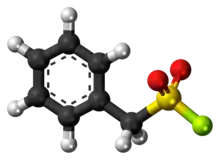PMSF
In biochemistry, phenylmethylsulfonyl fluoride (PMSF) is a serine protease inhibitor (serine hydrolase inactivator) commonly used in the preparation of cell lysates. PMSF does not inactivate all serine proteases.[1] The effective concentration of PMSF is between 0.1 - 1 mM. The half-life is short in aqueous solutions (110 min at pH 7, 55 min at pH 7.5, and 35 min at pH 8, all at 25 °C).[2] At 4˚C, pH 8, PMSF is almost completely degraded after 1 day.[2] Stock solutions are usually made up in anhydrous ethanol, isopropanol, or corn oil and diluted immediately before use.
 | |
 | |
| Names | |
|---|---|
| Preferred IUPAC name
Phenylmethanesulfonyl fluoride | |
| Identifiers | |
3D model (JSmol) |
|
| ChEBI | |
| ChEMBL | |
| ChemSpider | |
| ECHA InfoCard | 100.005.774 |
| KEGG | |
| MeSH | Phenylmethylsulfonyl+fluoride |
PubChem CID |
|
| UNII | |
CompTox Dashboard (EPA) |
|
| |
| |
| Properties | |
| C7H7FO2S | |
| Molar mass | 174.19 g·mol−1 |
| Appearance | Powder |
Except where otherwise noted, data are given for materials in their standard state (at 25 °C [77 °F], 100 kPa).
Infobox references | |
PMSF reacts specifically with the active site serine residue in serine hydrolases. It does not bind to any other serine residues in the protein. This is a result of the hyperactivity of that serine residue caused by the specific environmental conditions in the enzyme's active site (catalytic triad). Because PMSF bonds covalently to the enzyme, the complex can be viewed by X-ray crystallography; it can therefore be used as a chemical label to identify an essential active site serine in an enzyme.
- Enzyme(active)Ser-O-H + F-SO2CH2C6H5 → EnzymeSer-O-SO2CH2C6H5 + HF
- Serine protease + PMSF → Irreversible enzyme-PMS complex + HF
The median lethal dose between 150–215 mg/kg[3][4] (acetylcholine esterase inactivator). PMSF should be handled only inside a fume hood and while wearing gloves. DMSO is sometimes recommended as solvent for stock solutions, but should not be used as it makes intact skin permeable for PMSF.
Stability
The stability of PMSF in aqueous solutions is low, as it undergoes hydrolysis with water. PMSF is reportedly stable for ~6 months at -20˚C in DMSO,[5] and 9 months at room temperature in 100% isopropanol.[2][6]
Insensitive serine enzymes
Some proteins structure limit the accessibility of comparatively bulky PMSF, and therefore PMSF is inactive against these serine enzymes like palmitoyl-protein thioesterase.[7] Alternative sulfonyl fluoride reagents like p-APMSF and HDSF, have altered access to native folded protein structures, and may react with serine enzymes that PMSF cannot efficiently react with. This altered selectivity between sulfonyl fluoride reagents has been used to classify and isolate particular types of serine enzymes.[7]
See also
References
- Das, Amit K.; Bellizzi, John J.; Tandel, Sagun; Biehl, Edward; Clardy, Jon; Hofmann, Sandra L. (2000). "Structural Basis for the Insensitivity of a Serine Enzyme (Palmitoyl-Protein Thioesterase) to Phenylmethylsulfonyl Fluoride". Journal of Biological Chemistry. 275 (31): 23847–23851. doi:10.1074/jbc.M002758200. PMID 10801859.
- GT James (1978). "Inactivation of the protease inhibitor phenylmethylsulfonyl fluoride in buffers". Analytical Biochemistry. 86 (2): 574–9. doi:10.1016/0003-2697(78)90784-4. PMID 26289.
- Myers, D. K.; Kemp, A. (January 1954). "Inhibition of Esterases by the Fluorides of Organic Acids". Nature. 173 (4392): 33–34. doi:10.1038/173033a0. ISSN 1476-4687. PMID 13119739. S2CID 4164358.
- Pinsky, C.; Dua, A. K.; LaBella, F. S. (Sep 20–27, 1982). "Phenylmethylsulfonyl fluoride (PMSF) given systemically produces naloxone-reversible analgesia and potentiates effects of beta-endorphin given centrally". Life Sciences. 31 (12–13): 1193–1196. doi:10.1016/0024-3205(82)90340-x. ISSN 0024-3205. PMID 6292607.
- "Protease Inhibitors 101: Best Practices for Use in the Lab". Bitesize Bio. 2021-11-30. Retrieved 2023-06-22.
- "The Complete Guide for Protease Inhibition" (PDF). Roche. Retrieved 22 June 2023.
- Das, Amit K.; Bellizzi, John J.; Tandel, Sagun; Biehl, Edward; Clardy, Jon; Hofmann, Sandra L. (2000). "Structural Basis for the Insensitivity of a Serine Enzyme (Palmitoyl-Protein Thioesterase) to Phenylmethylsulfonyl Fluoride". Journal of Biological Chemistry. Elsevier BV. 275 (31): 23847–23851. doi:10.1074/jbc.m002758200. ISSN 0021-9258. PMID 10801859.
External links
- The MEROPS online database for peptidases and their inhibitors: PMSF